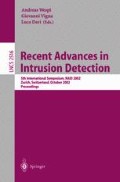Abstract
Vulnerability scanning and installing software patches for known vulnerabilities greatly affects the utility of network-based intrusion detection systems that use signatures to detect system compromises. A detailed timeline analysis of important remote-to-local vulnerabilities demonstrates (1) Vulnerabilities in widely-used server software are discovered infrequently (at most 6 times a year) and (2) Software patches to prevent vulnerabilities from being exploited are available before or simultaneously with signatures. Signature-based intrusion detection systems will thus never detect successful system compromises on small secure sites when patches are installed as soon as they are available. Network intrusion detection systems may detect successful system compromises on large sites where it is impractical to eliminate all known vulnerabilities. On such sites, information from vulnerability scanning can be used to prioritize the large numbers of extraneous alerts caused by failed attacks and normal background traffic. On one class B network with roughly 10 web servers, this approach successfully filtered out 95% of all remote-to-local alerts.
This work was sponsored by the Federal Aviation Administration under Air Force Contract F19628-00-C-0002. Opinions, interpretations, conclusions, and recommendations are those of the authors and are not necessarily endorsed by the United States Government.
Access this chapter
Tax calculation will be finalised at checkout
Purchases are for personal use only
Preview
Unable to display preview. Download preview PDF.
References
Arbaugh, W.A., W.L. Fithen, and J. McHugh, Windows of Vulnerability: A Case Study Analysis, IEEE Computer, 2000. 33,(12), 52–59, http://www.cs.umd.edu/~waa/pubs/Windows_of_Vulnerability.pdf.
CAIDA, Code-Red Worms: A Global Threat, Cooperative Association for Internet Data Analysis (CAIDA), 28 November 2001, http://www.caida.org/analysis/security/code-red/.
Chien, E., W32.Nimda.A@mm Worm, Symantec Corporation, 18 September 2001, http://www.symantec.com/avcenter/venc/data/w32.nimda.a@mm.html.
CVE, Common Vulnerabilities and Exposures, The MITRE Corporation, 2002, http://www.cve.mitre.org/.
Dayioglu, B. and A. Ozgit, Use of Passive Network Mapping to Enhance Signature Quality of Misuse Network Intrusion Detection Systems, in Proceedings of the Sixteenth International Symposium on Computer and Information Sciences, 2001, http://www.dayioglu.net/publications/iscis2001.pdf.
Dittrich, D., Distributed Denial of Service (DDoS) Attacks/tools, University of Washington, Seattle, 2001, http://staff.washington.edu/dittrich/misc/ddos/.
Dougherty, C., S. Hernan, J. Havrilla, J. Carpenter, A. Manion, I. Finlay, and J. Shaffer, CERT Advisory CA-2001-11 sadmind/IIS Worm, CERT Coordination Center, 8 May 2001, http://www.cert.org/advisories/CA-2001-11.html.
Fearnow, M. and W. Stearns, Lion Worm, SANS Institute, 29 March 2001, http://www.incidents.org/react/lion.php.
Forristal, J. and G. Shipley, Vulnerability Assessment Scanners, Network Computing, 8 January 2001, http://www.networkcomputing.com/1201/1201f1b1.html.
Hassell, R., R. Permeh, and M. Maiffret, UPNP-Multiple Remote Windows XP/ME/98 Vulnerabilities, eEye Digital Security, 20 December 2001, http://www.eeye.com/html/Research/Advisories/AD20011220.html.
Internet Software Consortium, ISC Berkeley Internet Name Domain (BIND) Domain Name System (DNS), January 2002, http://www.isc.org/products/BIND/.
Lestat, M., The Ramen Worm and its use of rpc.statd, wu-ftpd and LPRng Vulnerabilities in Red Hat Linux, SANS Institute, 7 February 2001, http://rr.sans.org/malicious/ramen.php.
Lippmann, R.P., J.W. Haines, D.J. Fried, J. Korba, and K. Das, The 1999 DARPA offline intrusion detection evaluation. Computer Networks, 2000. 32: pp. 579–595.
Mell, P. and T. Grance, The ICAT Metabase CVE Vulnerability Search Engine, National Institute of Standards and Technology, January 2002, http://icat.nist.gov .
Mueller, P. and G. Shipley, To Catch a Thief, Network Computing, 2001, http://www.networkcomputing.com/1217/1217f1.html.
Netcraft Web Server Survey, Netcraft Ltd., Bath England, October 2001, http://www.netcraft.com/survey/index-200110.html.
Nessus, The Nessus Security Scanner, 2002, http://www.nessus.org.
NSS Group, Intrusion Detection Systems Group Test (Edition 2), Ockwood House, Wennington, Cambridgeshire, England, December 2001, http://www.nss.co.uk/ids/.
Power, R., 2001 CSI/FBI Computer Crime and Security Survey, Computer Security Institute, Spring 2000, http://www.gocsi.com/forms/fbi/pdf.html.
Ptacek, T.H. and T.N. Newsham, Insertion, Evasion, and Denial of Service: Eluding Network Intrusion Detection. Secure Networks, Inc., 1998, http://secinf.net/info/ids/idspaper/idspaper.html.
Roesch, M. Snort-Lightweight Intrusion Detection for Networks, in USENIX 13th Systems Administration Conference-LISA’ 99. Seattle, Washington, 1999, http://www.snort.org.
SANS, The Twenty Most Critical Internet Security Vulnerabilities (Updated). Bethesda, MD, System Administration, Networking, and Security (SANS) Institute, 2001, http://www.sans.org/top20.htm.
SANS, NIMDA Worm/Virus Report-Final, System Administration, Networking, and Security (SANS) Institute, October 2001, http://www.incidents.org/react/nimda.pdf.
Spitzner, L., KnowYour Enemy: Passive Fingerprinting, Honeynet Project, January 2002, http://project.honeynet.org/papers/finger/.
Yocom, B., K. Brown, and D.V. DerVeer, Review: Intrusion-Detection Products Grow Up, Network World Fusion, 2001, http://www.nwfusion.com/reviews/2001/1008rev.html.
Author information
Authors and Affiliations
Editor information
Editors and Affiliations
Rights and permissions
Copyright information
© 2002 Springer-Verlag Berlin Heidelberg
About this paper
Cite this paper
Lippmann, R., Webster, S., Stetson, D. (2002). The Effect of Identifying Vulnerabilities and Patching Software on the Utility of Network Intrusion Detection. In: Wespi, A., Vigna, G., Deri, L. (eds) Recent Advances in Intrusion Detection. RAID 2002. Lecture Notes in Computer Science, vol 2516. Springer, Berlin, Heidelberg. https://doi.org/10.1007/3-540-36084-0_17
Download citation
DOI: https://doi.org/10.1007/3-540-36084-0_17
Published:
Publisher Name: Springer, Berlin, Heidelberg
Print ISBN: 978-3-540-00020-4
Online ISBN: 978-3-540-36084-1
eBook Packages: Springer Book Archive

